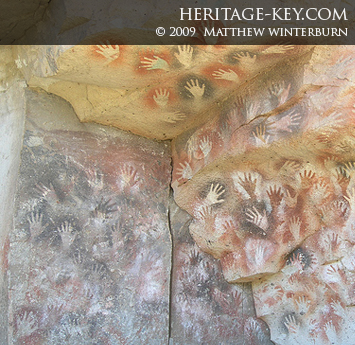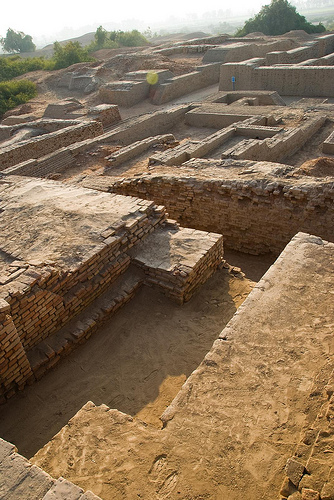Cave art is the oldest example of non-portable art in history, and dates back in some cases as far as 32,000 years. It can be found painted, scratched, etched, smudged and pecked onto the walls of caves all over the world, on almost every continent. Here we examine ten of the most famous sets of examples yet discovered.
Bhimbetka Rock Shelters, India
The spectacular Bhimbekta rock shelters in Madhya Pradesh, central India, contain the oldest traces of human life in the region. The vast selection of cave paintings and other forms of rock art found within them are the first known artistic expressions made by these people, and effectively chart their development over a span of 12,000 years, since the images appear to date from the Mesolithic Period right through to the historical period.
Lascaux Caves, France
There are 25 Palaeolithic-period decorated caves in the Vézère Valley in southwestern France, and Lascaux – discovered accidentally by teenagers in 1940 – is the most famous. There are 900 identifiable paintings there, and around 1,500 engravings. Mostly of animals – horses, stags, cattle, bison and other creatures – they are among the most detailed, lifelike and colourful ever seen, and may be as much as 16,000 years old. The four giant black bulls in the ‘Hall of the Bulls’ are the most striking images of them all. One is 5.2 metres long – the largest cave art animal yet found.
Creswell Crags, England
These caves, on the border between the counties of Derbyshire and Nottinghamshire in England, have been a significant archaeological site for decades. Yet, it was only as recently as 2003 that they yielded their most remarkable discovery – an array of engravings and bas-reliefs on walls and ceilings, of various animals and birds. It had previously been thought that no British cave art existed.
La Marche, France
Located in the Lussac-les-Châteaux area of western France, La Marche bears over 1,500 carved etchings, among them representations of animals and humans. They’re thought to date from as far back as 15,000 years ago. Yet, since its discovery in 1937, La Marche has been a controversial topic among cave art experts. Many question its validity, since its paintings and drawings are much more sophisticated than the stick figures often found in other caves of the period. Recent scientific opinion seems to be increasingly growing in its favour, however.
Drakensberg Mountains, South Africa
The Drakensberg Mountains contain the single largest and most concentrated collection of cave art anywhere on the planet. Some 35,000-40,000 pieces of bushman art have been found there – 1,146 individual examples in one cave, Sebaayeni, alone. Depicting both animals and human beings, the images are invaluable in their quality and diversity, and give a fascinating insight into the life of the San people who are known to have inhabited the region for more than four millennia.
Cosquer Cave, France
Cosquer Cave is located in the Calanque de Morgiou near Marseille, France. Named after the man who found it in 1985 – Henri Cosquer – its entrance is today 37 metres underwater, at the end of a 175 metre-long tunnel. Around four-fifths of the art within has been destroyed by the sea over the millenia, but still remaining are dozens of spectacular paintings and carvings – mostly of animals – from two periods of occupation as far back as the Upper Paleolithic period.
Cueva de la Pasiega, Spain
Essentially one of the world’s oldest and largest art galleries, Cueva de la Pasiega in Spain runs for some 120 metres, has six different external entrances and contains a warren of different cavities or “sanctuaries” each bearing art from different periods, sometimes painted and over-painted multiple times. They span practically the entire development of paleolithic art, from the Aurignacian period to the Magdalenian.
 Chauvet Cave, France
Chauvet Cave, France
Based on radiocarbon dating research carried out since 1996, Chauvet Cave – discovered in 1994 by Jean-Marie Chauvet – contains the oldest examples of cave art in the world. The hand prints, dots and animals – among them reindeer, horses, aurochs, rhinocerus and buffalo – marked on the walls there may be up to 32,000 years old (although this has been disputed by other experts). The fierce-looking lions are perhaps the most impressive of the site’s many images.
Cuevas de las Manos, Argentina
The image which defines Argentina’s Cuevas de las Manos and gives it its name is that of a wall coated with scores of human hands stenciled on top of each other with red ink. It’s one of the most famous cave art images in the world. There are also depictions of humans, guanacos, rheas, felines and other animals, as well as geometric shapes, zigzag patterns, representations of the sun and hunting scenes, within the same cave as well as others nearby (albeit on a smaller scale). All are thought to have been created between 13,000 and 9,500 years ago.
Altamira Cave, Spain
Because its galleries are located deep underground, and are therefore largely isolated from external climatic influences, the paintings in the Altamira Cave in Cantabria, Northern Spain, are among the best preserved in the world. The charcoal and ochre images of horses, goats, abstract shapes and handprints represent the apex of Paleolithic art. They found a notable fan in Pablo Picasso, who following a visit once famously exclaimed “after Altamira, all is decadence.”

